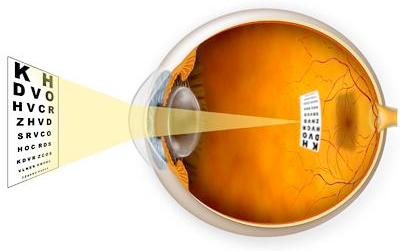Nearsightedness
 Myopia, better know as nearsightedness is a vision impairment which allows close objects to be seen clearly, but objects father away appear blurred. Nearsightedness occurs when the eyeball is too long or the cornea has too much curvature. When these problems exist the result is the light entering the eye isn’t focused correctly and distant objects look blurred.
Myopia, better know as nearsightedness is a vision impairment which allows close objects to be seen clearly, but objects father away appear blurred. Nearsightedness occurs when the eyeball is too long or the cornea has too much curvature. When these problems exist the result is the light entering the eye isn’t focused correctly and distant objects look blurred.
Nearly 30 percent of the U.S. population suffers from nearsightedness. While most research points to nearsightedness as being hereditary, recent research is supporting the theory that it may also be caused by visual stress of working too close up.
Nearsightedness usually first occurs in school-age children, because the eye continues to grow during childhood, it typically progresses until about age 20. However, it may also occur in adults due to visual stress or heath conditions such as diabetes.
An optometrist can prescribe eyeglasses, contact lenses or colored contact lenses that correct nearsightedness by bending the visual images that enter the eyes, focusing the images correctly at the back of the eye. Depending on the amount of nearsightedness, you may only need to wear glasses or contact lenses for certain activities, like watching a movie or driving a car. Or, if you are very nearsighted, they may need to be worn all the time.
Another option for treating nearsightedness is corneal refractive therapy. It is a non-surgical procedure that involves wearing a series of specially designed rigid contact lenses to gradually reshape the curvature of your cornea. The lenses place pressure on the cornea to flatten it. This changes how light entering the eye is focused.
Laser surgery is another possible treatment for nearsightedness in adults. This involves reshaping the cornea by removing a small amount of eye tissue. It is accomplished by using a highly focused laser beam on the surface of the eye.
Refractive surgery procedures are available for people with higher levels of nearsightedness. Similar to procedures used in cataract surgery, the surgery involves implanting a small lens with the optical corrections directly inside the eye, either in front of the natural lens or replacing the natural lens.
Persons with nearsightedness have several options available to regain clear distance vision. They include;
• Eyeglasses
• Contact lenses
• Orthokeratology or corneal refractive therapy
• Laser and other refractive surgery procedures
• vision therapy for persons with stress-related nearsightedness
Eyeglasses are the primary choice of correction for persons with nearsightedness. Generally, a single vision lens is prescribed to provide clear vision at all distances. However, for patients over about age 40, or children and adults whose nearsightedness is due to the stress of near vision work, a bifocal or progressive addition lens may be needed. These multifocal lenses provide different powers or strengths throughout the lens to allow for clear vision in the distance and also clear vision up close.
Rather your options are eyewear, contact lenses or Lasik surgery the first step is seeing a eye doctor for an examination to determine the level of nearsightedness and what options will have you seeing better. Make an appointment today with an eye care clinic and discuss your option with a certified eye care physician.
For additional information or to schedule an Eye Examination, please contact us at (866) 611-7556.
Also Serving:
Sealy, TX - Bellville, TX - Columbus, TX - Katy, TX |
